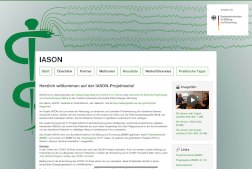Tokeya is a young company from Würzburg (founded in July 2017) and provider of products and services in the fields of
- qEEG - quantitative analysis of the electroencephalogram (EEG)
- Sensory neuromodulation (optical, acoustic, somatic-sensory)
- Innovative diagnostics and therapy based on qEEG and sensory neuromodulation for patients suffering from Alzheimer’s disease, severe depression or post-COVID neurological syndrome. This also includes novel symptoms similar to Parkinson’s disease.
For this, Tokeya uses advanced signal analysis techniques, taking into account methods from artificial intelligence (AI).
The diagnostic software tools developed by Tokeya aim at early, preclinical detection of the presence of Alzheimer’s disease (AD), major depressive disorder (MDD), or post-COVID neurological syndrome (PCNS), including Parkinson’s-like symptoms (PD) at an asymptomatic stage, if possible.
Based on the aforementioned preclinical early diagnosis with qEEG, the therapeutic software/hardware tools developed by Tokeya especially for sensory neuromodulation aim at an extensive alleviation or even possible elimination of the respective severe symptoms such as limitation or reduction of short-term memory (AD and PCNS), listlessness (MDD, PD, PCNS), insomnia (MDD, AD, PCNS) and headache and limb pain (PCNS).
We hereby try to make our contribution to the people in the times of COVID-19 pandemic based on our findings of the connections between AD, MDD and PCNS.
Please have a look at our homepage and our offer and feel free to contact us. We are looking forward to your inquiries!
📰 News
-
New homepage launched!
We are pleased to present you our homepage in a new design! We have put the focus on our current developments in the field of neuronal entrainment by means of sensory neurostimulation and neuromodulation in the gamma frequency range. A small animation, which you can start in the upper left corner, would like to illustrate the underlying principle.
Like every homepage, ours is in continuous development. This is especially true for the products which are created in the course of our research and which we will describe in detail and offer to you on our homepage at the respective market launch.
The original homepage can still be viewed. We are looking forward to your feedback!
-
Poster presentation at AAIC 21
Our poster on the transition zone between motor and cognitive function in Long Covid, Parkinson’s and Alzheimer’s disease patients was published at AAIC 21 (26 - 31/07/21) in Denver, Colorado, USA.
A new EEG biomarker, the Frontal Asymmetry Index (FAI), was presented that can be used to clearly distinguish between Alzheimer’s disease patients and control subjects.
Furthermore, first results of 40 Hz neurostimulation in a Long COVID patient suffering from tremor and chronic fatigue syndrome were presented.
The first results justify the statement that sensory neurostimulation at 40 Hz can eliminate the pathological peaks at 20 Hz typical of tremor and Parkinson’s disease. The durability of this effect as well as the transferability to Alzheimer’s disease are currently being investigated.
Files:
- Poster presentation (MP4, 1920×1080 px, 5,2 MB)
- Slides (PDF, 10,8 MB)
- Abstract (PDF, 353 KB)
- Transcript (PDF, 66 KB)
- Questions and answers (PDF, 141 KB)
-
Increase in funding & announcement of the pilot study FHASE
We are very pleased to announce that the BMBF has approved an increase of the funding for our IASON project. We will use the new funds to develop an app combining an automated olfactory and memory test, the two positive results of which allow us to predict that people will NOT develop Alzheimer’s disease with a probability of 96% within the next 4 years. The olfactory test will also be used to clarify symptoms of COVID-19 odour loss.
Most importantly, we will use the financial increase to plan, prepare and conduct a pilot study called FHASE (Forty Hertz (40 Hz) Alzheimer Stimulation and Entrainment), which will make it possible to significantly increase the effect strength of a combined 40 Hz Gamma Entrainment (optical, acoustic, mechanical, electrical) using an individual setting compared to previous approaches to Gamma Entrainment. We hope to gain decisive impulses for a sustainable, non-invasive, non-drug therapy of Alzheimer’s disease.
“Entrainment” here means “rhythmic coupling of brain waves in the gamma frequency range (40 Hz)” by external (sensory) or internal (e.g. electrodes in the brain) stimulation. Entrainment here has the figurative meaning of “getting back into a synchronously running train (of oscillations)”. It is precisely this synchronicity that is lost in Alzheimer’s disease. Gamma Entrainment restores a normal (“healthy”) synchronization of the brain waves and at the same time eliminates the causes (e.g. plaques or tangles) of their disruption by the microglia cells. To show this improvement for humans and not only for mice is the declared goal of the FHASE pilot study.
A further central goal is to use the accompanying measurements (especially EEG) during gamma entrainment in the waking and sleeping states to gain insights that allow a prognosis of the future manifestation of Alzheimer’s disease already in its preclinical phase or in the MCI precursor state.
Then it would also be possible to postpone or even prevent the future occurrence of Alzheimer’s disease by an intervention with 40 Hz Gamma Entrainment. Details on this can be found at www.iason.ai.
The Internet domains www.iason.health and www.iason.healthcare currently refer to www.iason.ai, but will have their own contents in the future.
-
New blood test for Alzheimer’s biomarkers
New blood test for the highly differentiated determination of Alzheimer-specific biomarkers in blood developed. Further information can be found at www.biofinder.se and in the news of www.iason.ai and at “Updates on the state of the art”.
-
Project homepage online
We are pleased to announce that the new homepage for the IASON project is now published and accessible at www.iason.ai.







 English
English  Deutsch
Deutsch